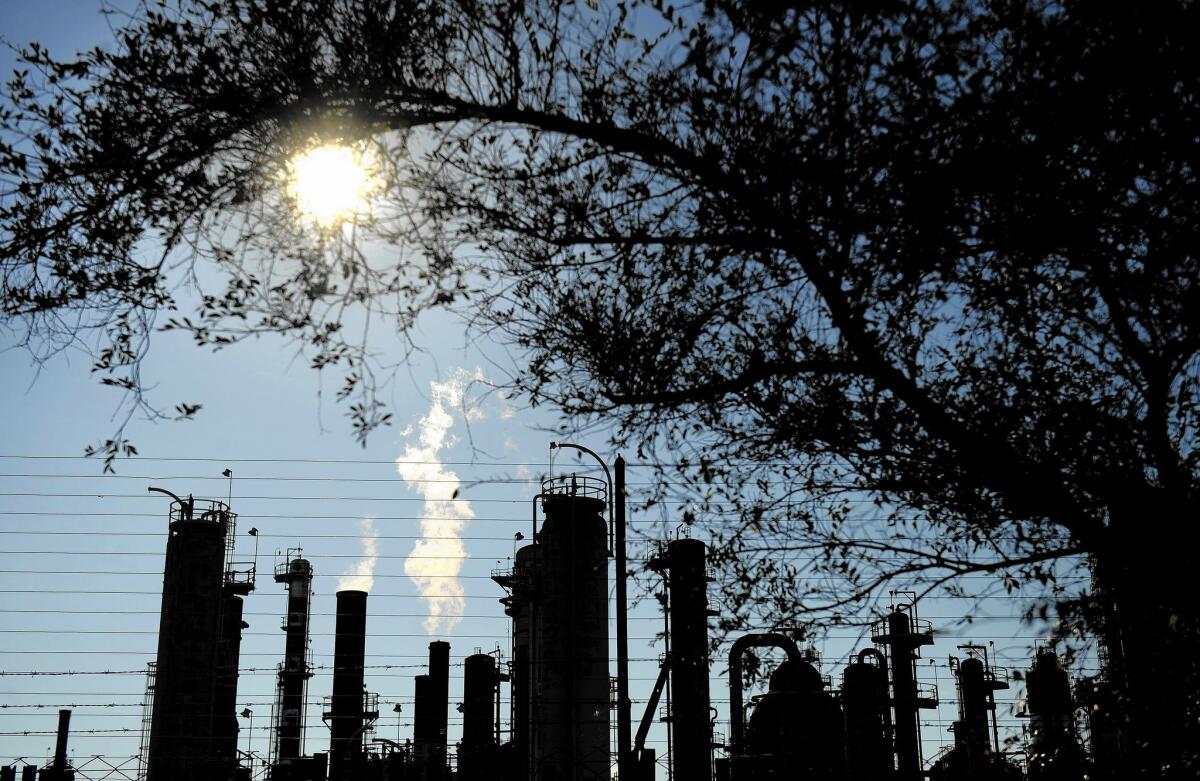California air regulators readopt fuel standard to fight climate change

The state Air Resources Board is expected to add several provisions to its low-carbon fuel program. Above, the Exxon Mobil refinery in Torrance.
- Share via
California air quality officials on Friday approved updates to a key climate change rule that will force reductions in carbon pollution from gasoline and diesel fuel over the next five years.
The vote Friday by the Air Resources Board to readopt its low-carbon fuel standard will require California to achieve at least a 10% cut in the carbon intensity of transportation fuels by 2020.
The move is one indication of how California officials will use existing regulations, rather than new laws, to continue their climate change efforts after Gov. Jerry Brown and Democratic lawmakers were forced this month to drop legislative proposals to cut petroleum use and reduce greenhouse gas emissions.
Environmental groups support the low-carbon fuel standard as a way to promote the use of natural gas, biodiesel, electricity and other less-polluting fuels, but oil producers warn it will raise costs to drivers.
Consumers can expect to pay an extra 4 cents per gallon of gasoline in 2016 and up to 13 cents more per gallon in 2020 as a result of the low-carbon fuel standard, according to the air board.
California’s fuel standard, along with its cap-and-trade program and other initiatives, is central to the state’s ambitious goals to reduce the greenhouse gas emissions that are warming the planet.
The market-based program imposes a gradually declining cap on the amount of carbon generated from “well to wheel,” including oil extraction, fuel production and distribution. Companies that produce gasoline, diesel and other fuels must demonstrate each year that they have met carbon-reduction targets, either directly or by purchasing credits from clean-fuel producers that surpass those standards.
The rule, adopted in 2009, was challenged in court by industry groups. The fuel standard has remained in effect since 2011, but the air board must reapprove the regulation to satisfy a court ruling in a lawsuit filed by ethanol producers that found procedural problems with how it was adopted.
The air board also added several provisions, including an attempt to limit costs and provide greater certainty to the oil industry by placing a cap on the price of credits.
Another measure streamlines the application process for alternative-fuel producers seeking credits.
At a public hearing Thursday in Sacramento, the Air Resources Board heard testimony from opponents in the oil industry as well as from renewable-fuel companies and environmental groups that support the fuel standard and say it already is working to clean the air and lower carbon emissions.
The air board’s regulations are “putting us on the road to halving our oil use,” said Jason Barbose, Western states policy manager for the Union of Concerned Scientists.
The oil industry opposed the rule.
“There are still not enough low-carbon biofuels available in sufficient quantities to allow refiners to comply with the regulations,” Catherine Reheis-Boyd, president of the Western States Petroleum Assn., said in a statement. “In addition, the vastly accelerated compliance schedule … puts even more upward pressure on fuel costs.”
The action by air pollution regulators comes two weeks after Gov. Brown and state Senate leader Kevin de León (D-Los Angeles) dropped a proposal to cut petroleum use in half over the next 15 years. The legislation drew opposition from the oil industry and resistance from some Democratic lawmakers.
Another piece of Brown’s climate change agenda, a law to codify Brown’s executive order to cut greenhouse gas 40% below 1990 levels by 2030, also was pulled from consideration. But requirements to improve energy efficiency in buildings and increase the use of renewable electricity survived.
Twitter: @tonybarboza
ALSO:
China’s leader to announce carbon emissions limits
California is ahead of the game as Obama releases Clean Power Plan
U.S. and China aim to hit climate goals sooner than expected in some cities







